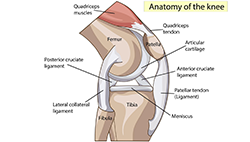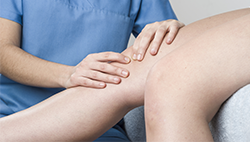Treat Patellar Tendinitis at MidAmerica’s Palos Hills & Mokena Locations

Patellar tendinitis, also known as “jumper’s knee,” is an injury to the tendon connecting the kneecap (patella) to the shinbone (tibia). The patellar tendon works with the muscles at the front of the thigh to enable running, kicking and jumping. This condition is most common in athletes whose sports involve frequent jumping (such as basketball and volleyball players) though it is possible for non-athletes to develop this condition as well. Patellar Tendinitis is common sports injury, and is treatable at MidAmerica’s Palos Hills and Mokena Sports Medicine Clinics. (Mayo Clinic)
Causes
Patellar tendinitis is an overuse injury caused by repetitive stress on the knee, causing tiny tears in the tendon which inflame and weaken the tendon over time. Athletes are more at risk to develop this condition because running, jumping, and squatting increase stress on the patellar tendon. (Health Line)
Contributing factors include:
- Shoes without proper padding
- Hard playing surfaces
- Tight leg muscles
- Uneven leg muscle strength
- Misaligned feet, legs, or ankles
- Obesity
- Chronic diseases that weaken the tendon (Health Line)
Patellar Tendonitis Symptoms
Pain between the kneecap and where the tendon attaches to the shinbone is usually the first sign of patellar tendonitis. Additional symptoms include:
- Pain during or after physical activity
- Swelling or burning in the kneecap
- Pain when kneeling or squatting
- Pain when climbing stairs, sitting in a car, or rising from a chair
Schedule an appointment with your doctor if patellar tendonitis symptoms last for more than two days, interfere with your ability to perform daily activities, or are associated with swelling or redness at the joint. (Mayo Clinic)
Common Misconceptions
There are two common misconceptions associated with patellar tendonitis:
Myth #1: Tendinitis is caused by inflammation
While inflammation can be involved in tendon pain, it is not its primary driver. The main cause of tendon pain is mechanical overloading, the result of which is inflammation. This is why, more frequently, physicians are referring to tendon pain as “tendinopathy” to more accurately reflect its pathology. (Velocity Sports Rehab)
Myth #2 Rest is Best
In the initial stages of treating tendonitis, reducing workload on the tendon may be necessary to calm inflammation. However, prolonged resting can cause stress-shielding which causes the tendon to weaken. Also, returning to the same activity level after long periods of rest spikes the load on the tendon, increasing the likelihood of reinjury. (Velocity Sports Rehab)

Diagnosis
On your initial visit, your physician may apply pressure to parts of your knee to determine the source of the pain. Usually, pain from patellar tendinitis is located at the front of the knee, just below the kneecap. Your physician may also extend your knee to test your range of motion. (Health Line)
Additionally, your doctor may schedule an X-ray to exclude other bone problems that can cause knee pain, an ultrasound, to reveal possible tears in your patellar tendon, or an MRI to reveal subtle changes in the patellar tendon. (Health Line)
Patellar Tendonitis Treatment
Most cases of patellar tendonitis do not require surgery and a multitude of non-operative treatment options are available, including:
NSAIDs
Medications such as ibuprofen and naproxen may provide short-term pain relief
Physical Therapy
Sessions include stretching exercises to reduce muscle spasms and strengthening exercises to improve thigh muscle strength
Patellar tendon strap
A strap that applies pressure to the patellar tendon to distribute force away from the tendon, thus reducing pain
Corticosteroid Injection
An injection in the area around the patellar tendon proven to reduce severe pain. However, this method may weaken the tendon and make it more likely to rupture. (Spine Ortho Center)

Surgery
If non-surgical methods have proven ineffective, surgery is available at MidAmerica’s Palos Hills and Mokena locations. Most commonly, arthroscopic surgery is used to treat this condition. This method involves making four small incisions at the knee, removing abnormal tissue and the lower portion of the patella. This surgical method encourages a more natural healing process and has a shorter recovery time than traditional methods. Recovery time from surgery varies, however, most patients are able to return to high level activity in three months to a year. (Health Line)
For specialized care, turn to MidAmerica’s Sports Medicine and Arthroscopy Specialist, Adam F. Meisel. He strives to help his patients regain and maintain their active lifestyles by offering both operative and non-operative approaches to treatment. He is active in research related to hip arthroscopy, rotator cuff repairs, and patellar tendonitis treatment.
Postoperative Care

Dr. Adam F. Meisel
At MidAmerica Orthopaedics Palos Hills and Mokena clinics, our post-surgery physical therapy and rehabilitation consists of recommended exercises and stretches, as well as training in proper bending and lifting techniques to avoid future injuries. Our regiments aim to get our patients back on their feet and returning to daily activities. To schedule an appointment with MidAmerica Orthopaedics Sports Medicine and Arthroscopy Specialist, Adam F. Meisel, call (708) 237-7200, or request an appointment online.
To learn more about MidAmerica Orthopaedics and the different patellar tendonitis treatment options available, visit our website.
We proudly serve Palos Hills, Mokena, Chicago, Oak Lawn, and Orland Park.

